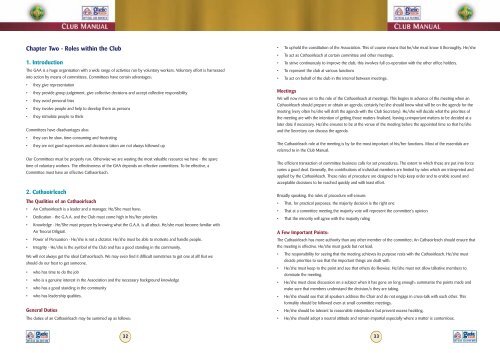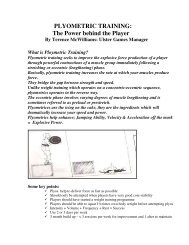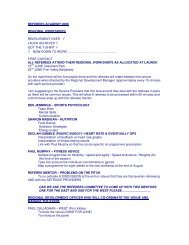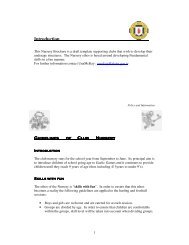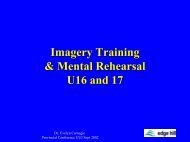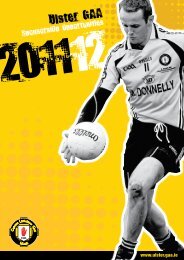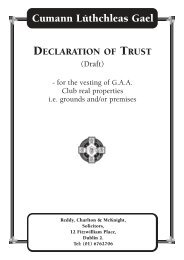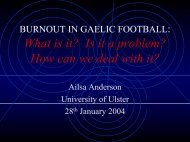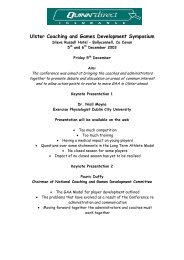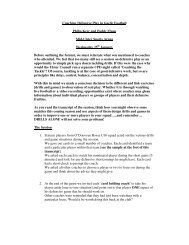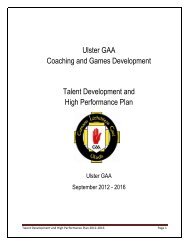Club Manual - Ulster GAA
Club Manual - Ulster GAA
Club Manual - Ulster GAA
Create successful ePaper yourself
Turn your PDF publications into a flip-book with our unique Google optimized e-Paper software.
Chapter Two - Roles within the <strong>Club</strong><br />
1. Introduction<br />
The <strong>GAA</strong> is a huge organisation with a wide range of activities run by voluntary workers. Voluntary effort is harnessed<br />
into action by means of committees. Committees have certain advantages:<br />
• they give representation<br />
• they provide group judgement, give collective decisions and accept collective responsibility<br />
• they avoid personal bias<br />
• they involve people and help to develop them as persons<br />
• they stimulate people to think<br />
Committees have disadvantages also:<br />
• they can be slow, time-consuming and frustrating<br />
• they are not good supervisors and decisions taken are not always followed up<br />
Our Committees must be properly run. Otherwise we are wasting the most valuable resource we have - the spare<br />
time of voluntary workers. The effectiveness of the <strong>GAA</strong> depends on effective committees. To be effective, a<br />
Committee must have an effective Cathaoirleach.<br />
2. Cathaoirleach<br />
The Qualities of an Cathaoirleach<br />
• An Cathaoirleach is a leader and a manager. He/She must have:<br />
• Dedication - the G.A.A. and the <strong>Club</strong> must come high in his/her priorities<br />
• Knowledge - He/She must prepare by knowing what the G.A.A. is all about. He/she must become familiar with<br />
An Treoraí Oifigiúil.<br />
• Power of Persuasion - He/she is not a dictator. He/she must be able to motivate and handle people.<br />
• Integrity - He/she is the symbol of the <strong>Club</strong> and has a good standing in the community.<br />
We will not always get the ideal Cathaoirleach. We may even find it difficult sometimes to get one at all! But we<br />
should do our best to get someone.<br />
• who has time to do the job<br />
• who is a genuine interest in the Association and the necessary background knowledge<br />
• who has a good standing in the community<br />
• who has leadership qualities.<br />
General Duties<br />
The duties of an Cathaoirleach may be summed up as follows:<br />
• To uphold the constitution of the Association. This of course means that he/she must know it thoroughly. He/she<br />
• To act as Cathaoirleach at certain committee and other meetings.<br />
• To strive continuously to improve the club; this involves full co-operation with the other office holders.<br />
• To represent the club at various functions<br />
• To act on behalf of the club in the interval between meetings.<br />
Meetings<br />
We will now move on to the role of the Cathaoirleach at meetings. This begins in advance of the meeting when an<br />
Cathaoirleach should prepare or obtain an agenda; certainly he/she should know what will be on the agenda for the<br />
meeting (very often he/she will draft the agenda with the <strong>Club</strong> Secretary). He/she will decide what the priorities of<br />
the meeting are with the intention of getting those matters finalised, leaving unimportant matters to be decided at a<br />
later date if necessary. He/she ensures to be at the venue of the meeting before the appointed time so that he/she<br />
and the Secretary can discuss the agenda.<br />
The Cathaoirleach role at the meeting is by far the most important of his/her functions. Most of the essentials are<br />
referred to in the <strong>Club</strong> <strong>Manual</strong>.<br />
The efficient transaction of committee business calls for set procedures. The extent to which these are put into force<br />
varies a good deal. Generally, the contributions of individual members are limited by rules which are interpreted and<br />
applied by the Cathaoirleach. These rules of procedure are designed to help keep order and to enable sound and<br />
acceptable decisions to be reached quickly and with least effort.<br />
Broadly speaking. the rules of procedure will ensure:<br />
• That, for practical purposes, the majority decision is the right one<br />
• That at a committee meeting the majority vote will represent the committee's opinion<br />
• That the minority will agree with the majority ruling<br />
A Few Important Points:<br />
The Cathaoirleach has more authority than any other member of the committee; An Cathaoirleach should ensure that<br />
the meeting is effective. He/she must guide but not lead.<br />
• The responsibility for seeing that the meeting achieves its purpose rests with the Cathaoirleach. He/she must<br />
decide priorities to see that the important things are dealt with.<br />
• He/she must keep to the point and see that others do likewise. He/she must not allow talkative members to<br />
dominate the meeting.<br />
• He/she must close discussion on a subject when it has gone on long enough: summarise the points made and<br />
make sure that members understand the decision/s they are taking.<br />
• He/she should see that all speakers address the Chair and do not engage in cross-talk with each other. This<br />
formality should be followed even at small committee meetings.<br />
• He/she should be tolerant to reasonable interjections but prevent excess heckling.<br />
• He/she should adopt a neutral attitude and remain impartial especially where a matter is contentious.<br />
32<br />
33


